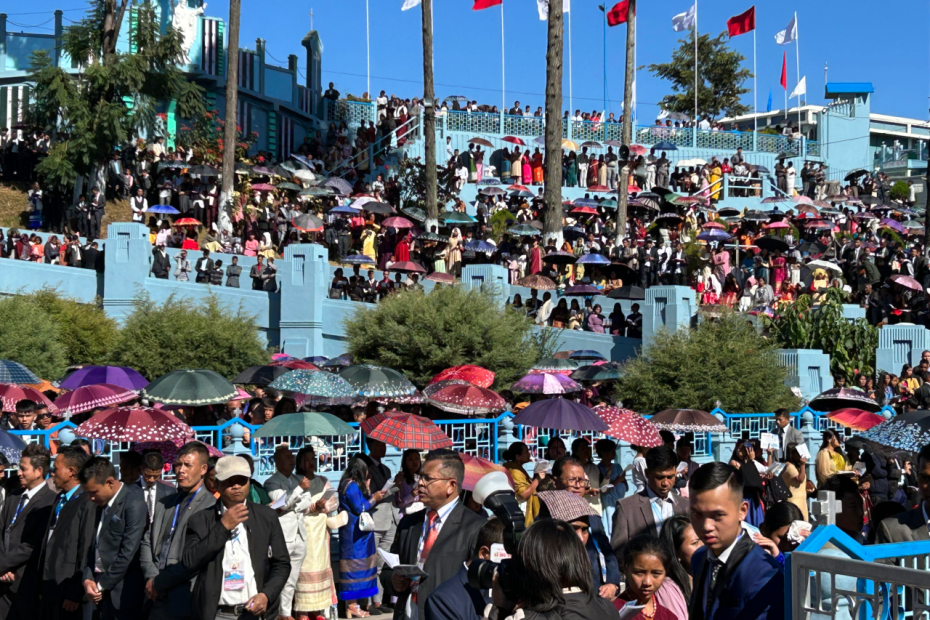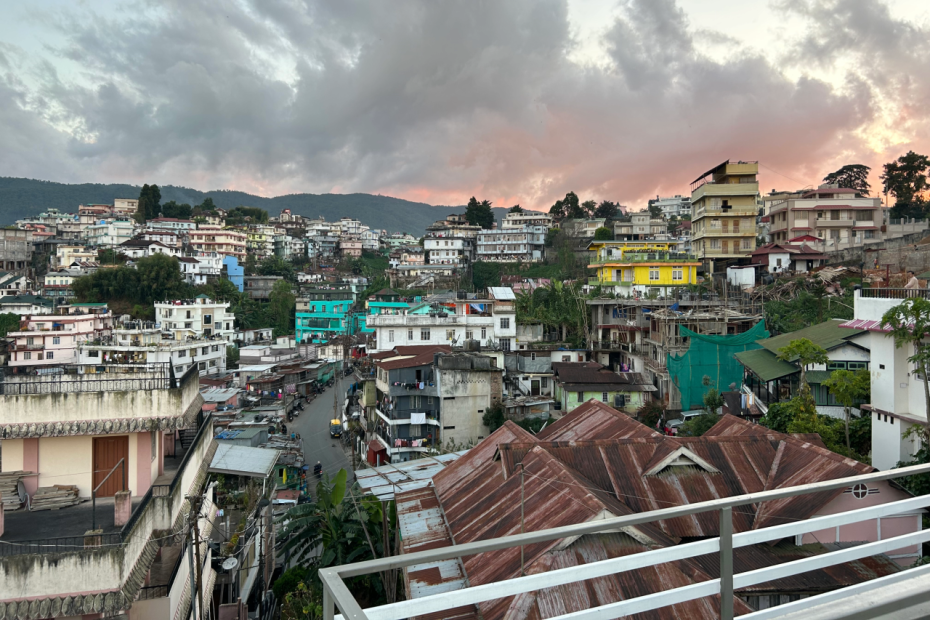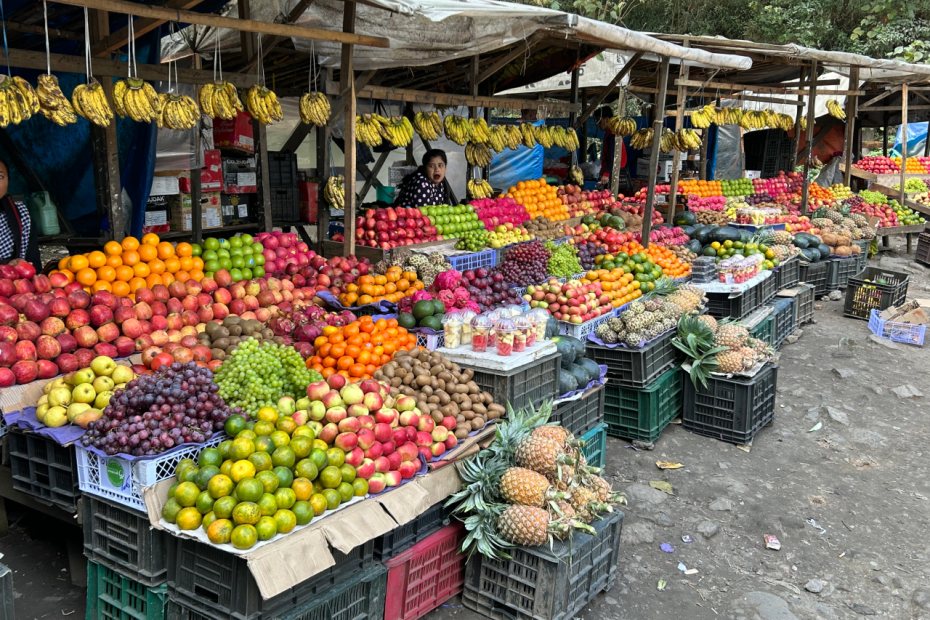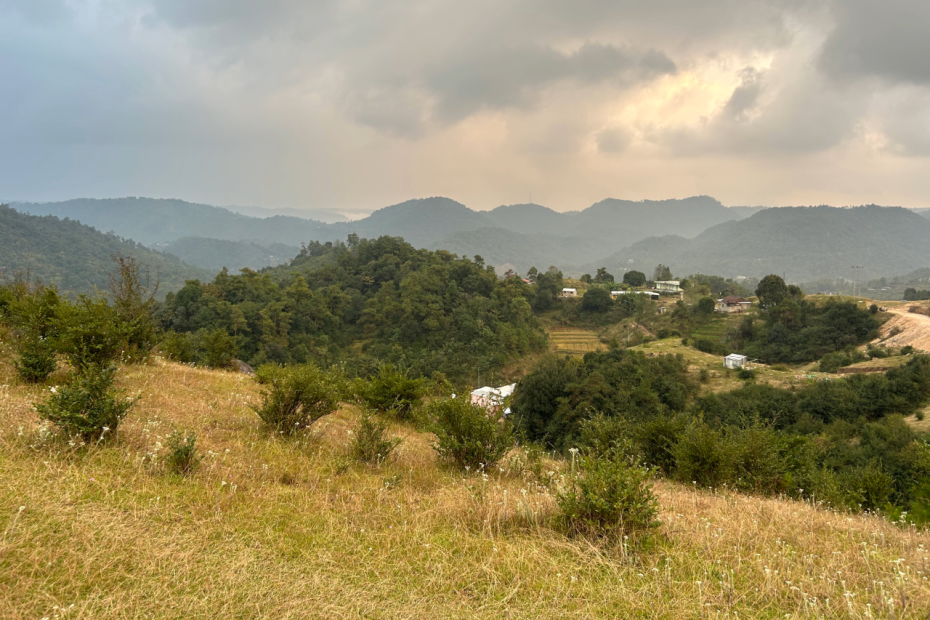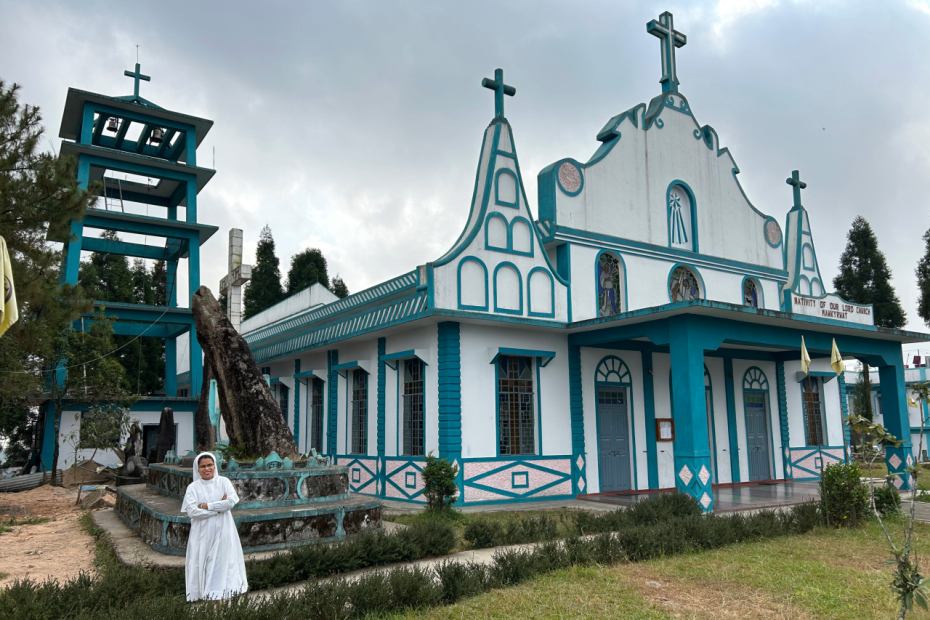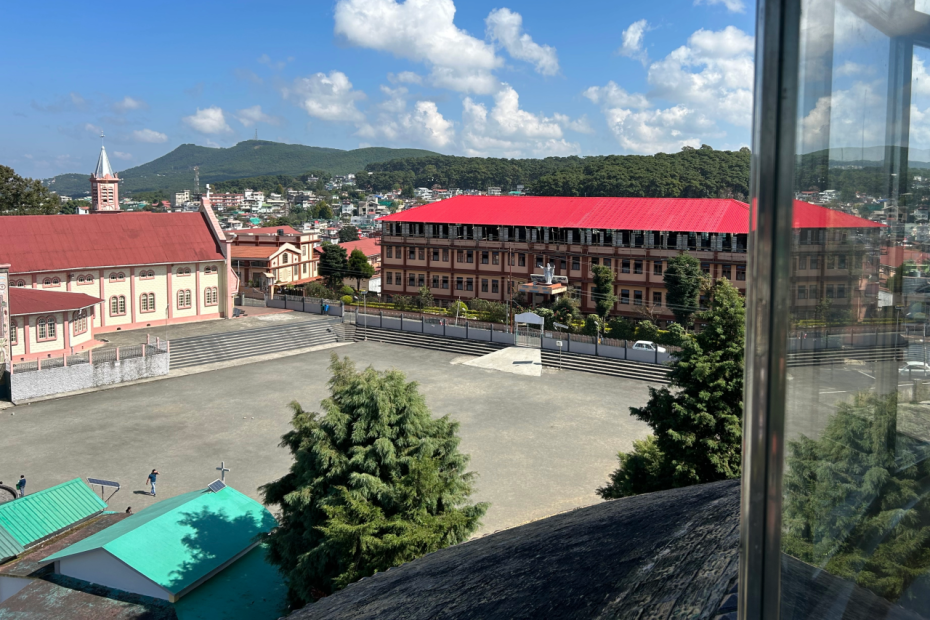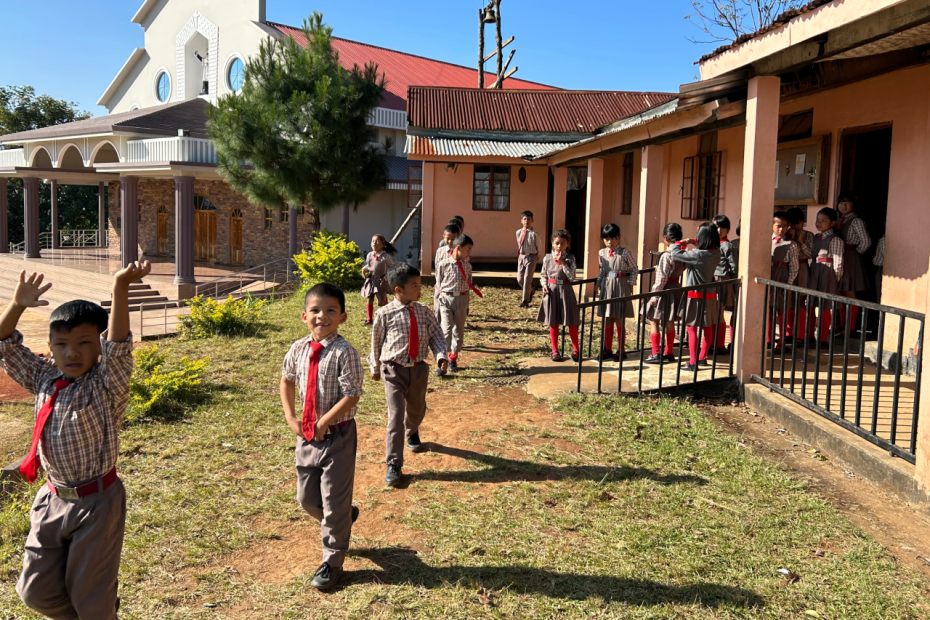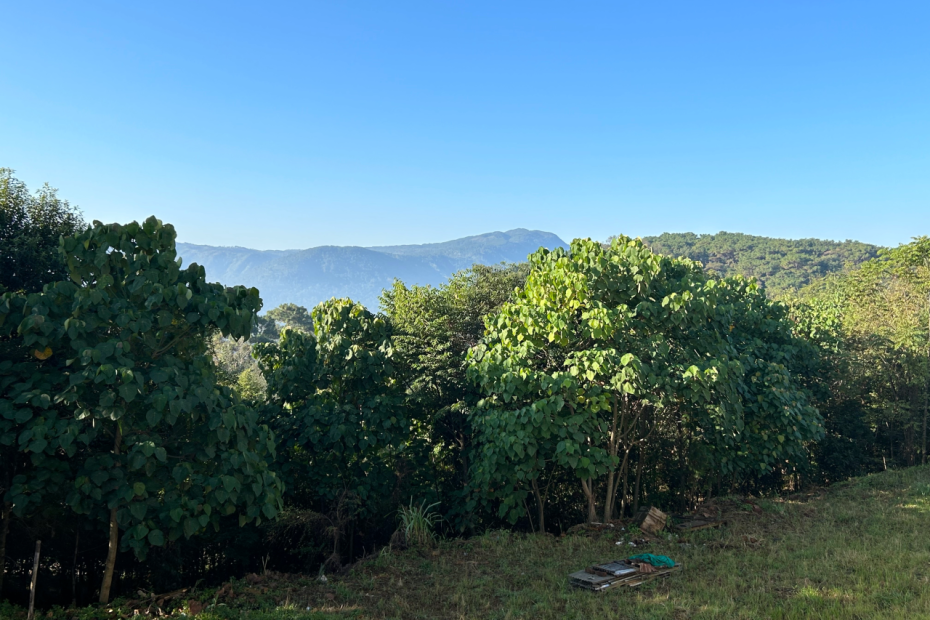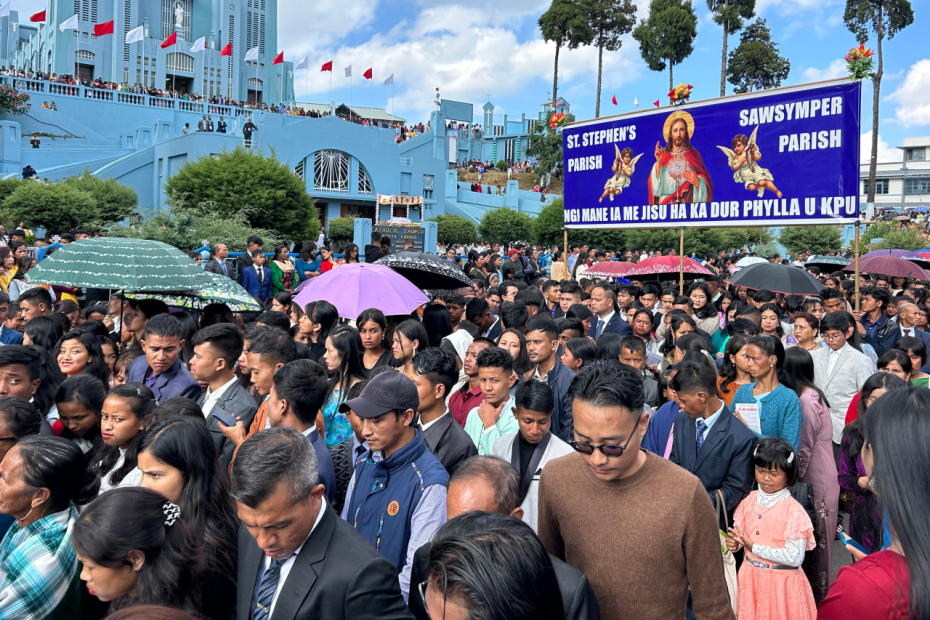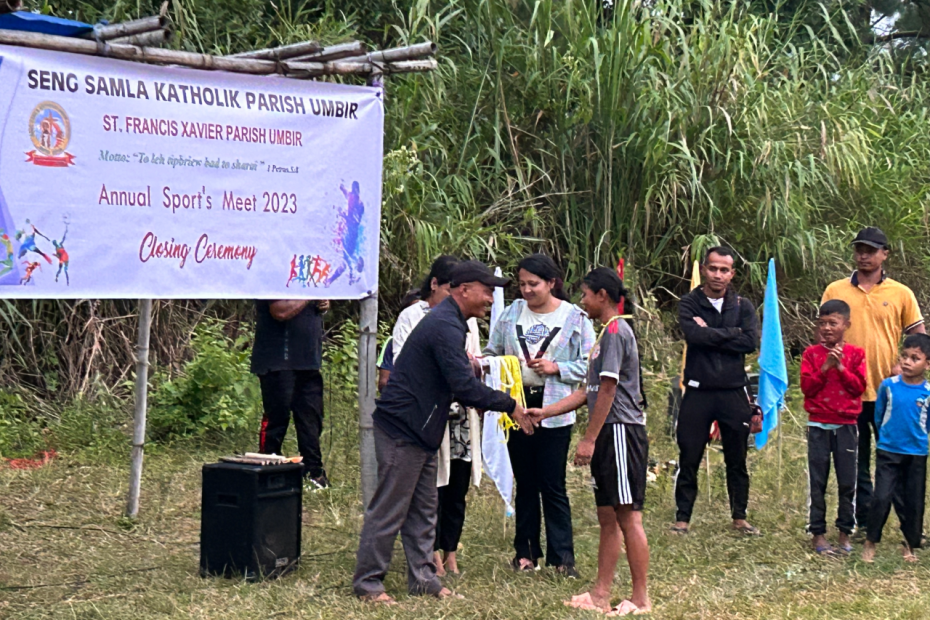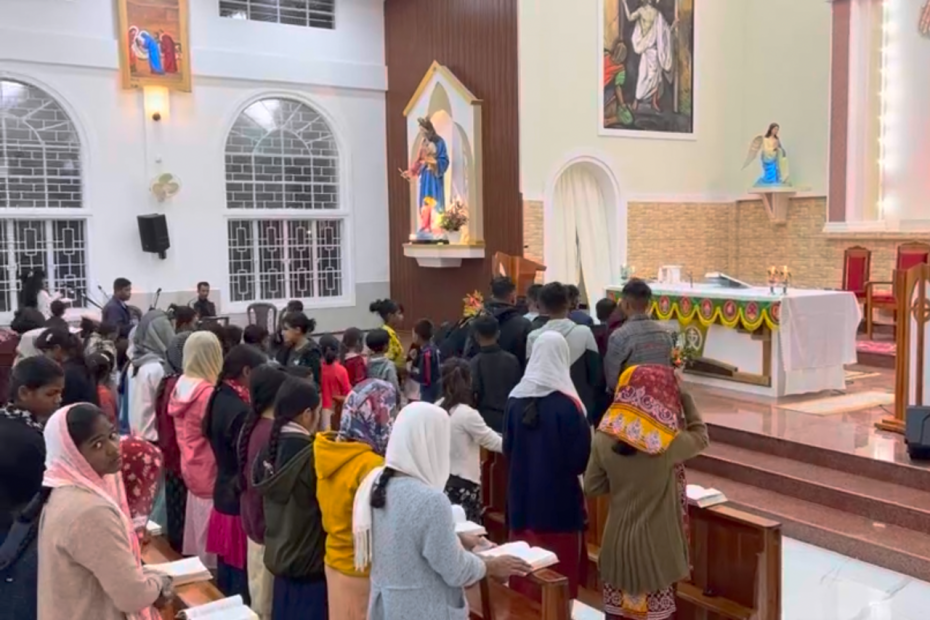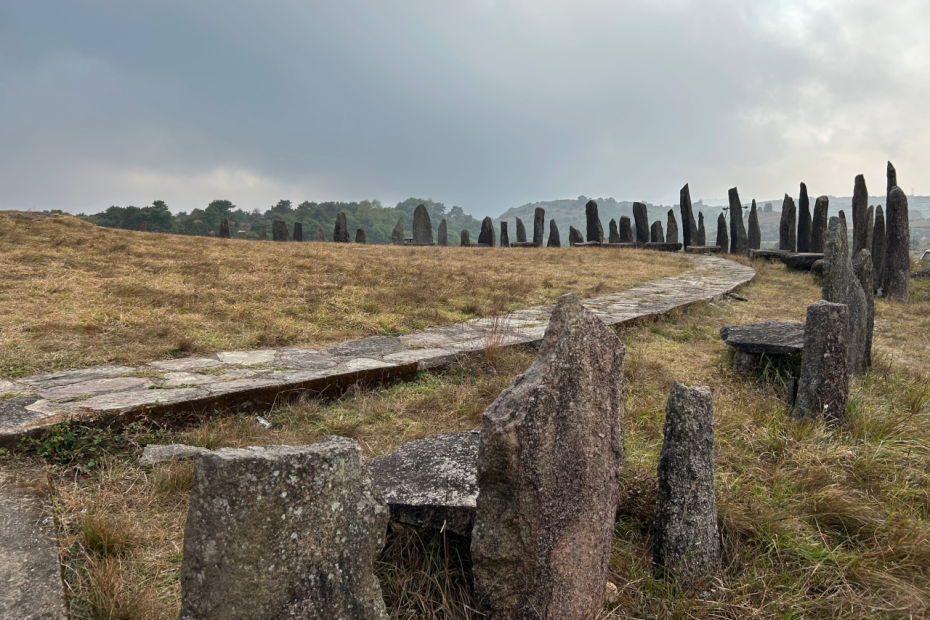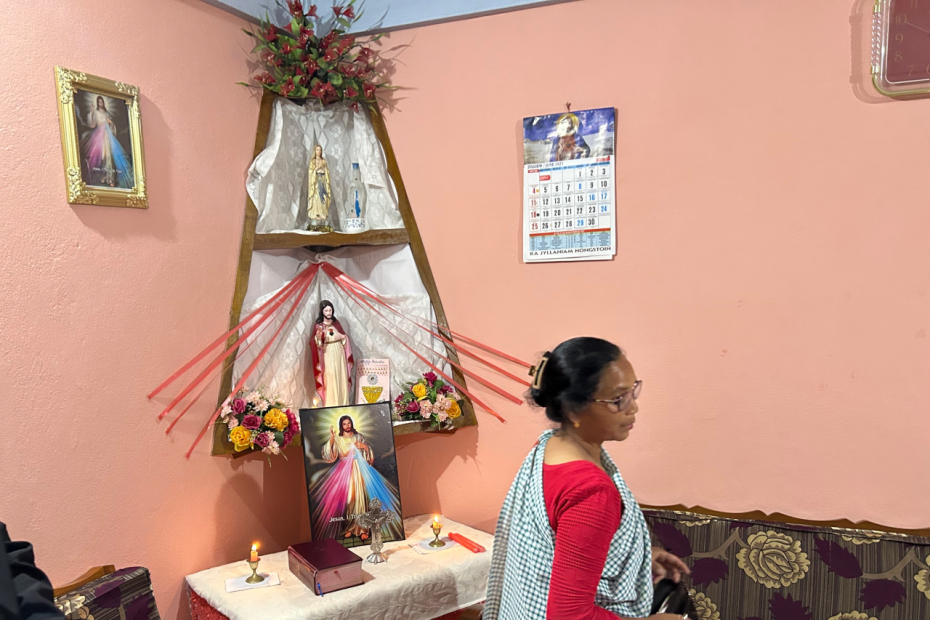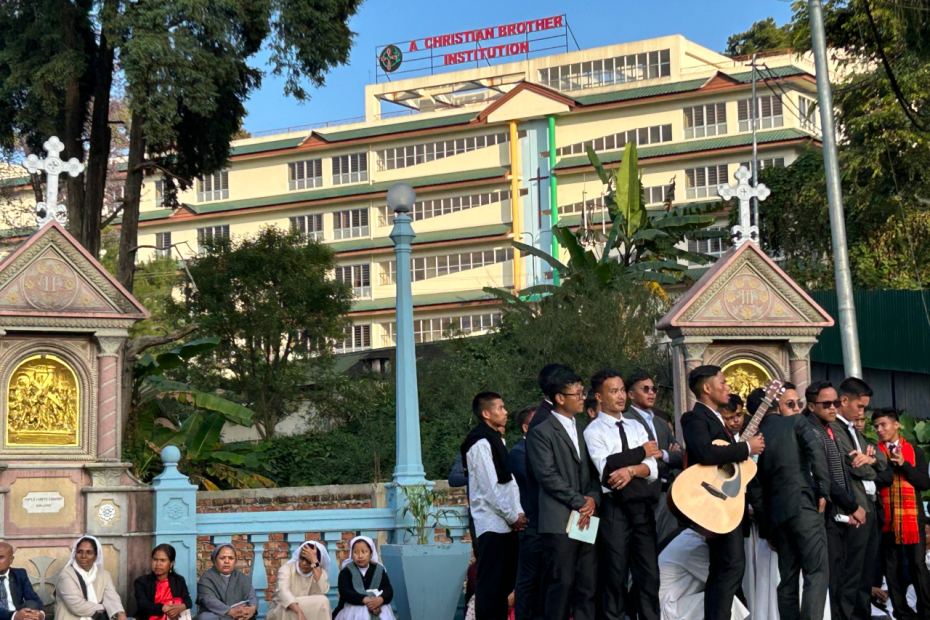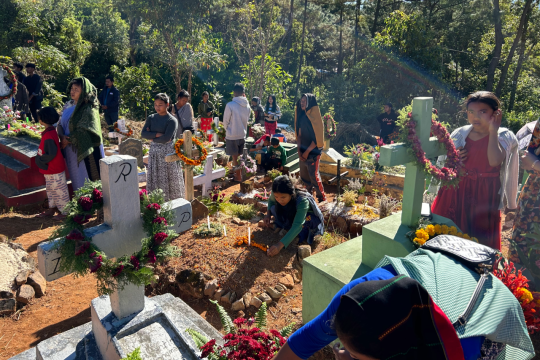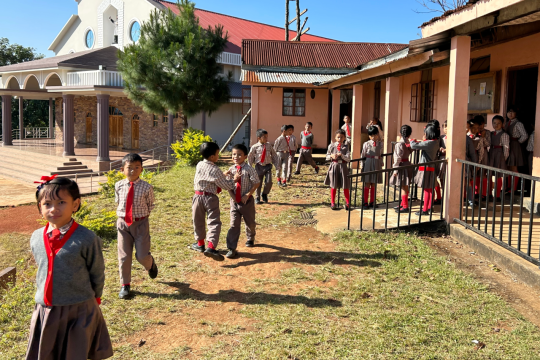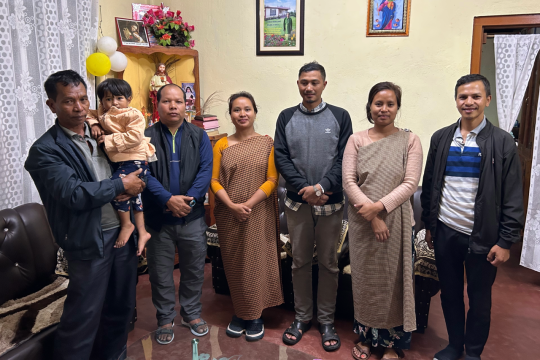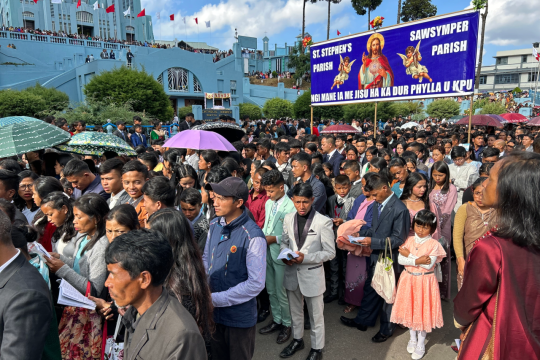Any attempt to describe Indian Catholic life in broad terms runs up against the genuine diversity of a country misperceived by many foreigners to be culturally and linguistically monolithic. The Northeast region, primarily bounded by Bangladesh, Bhutan, Myanmar, and China, yet linked to the rest of India by a narrow land bridge, is one place where India’s diversity is particularly apparent. The Northeast region not only stands out culturally, linguistically, and religiously from “mainland” India but is also incredibly diverse within. It is the only part of India to have states that are majority Christian: Meghalaya, Mizoram, and Nagaland are each more than three-quarters Christian and Manipur is proportionately more Christian than Goa and Kerala, which are often regarded as India’s Catholic strongholds.1 In the seven states that comprise the Northeast region, more than 200 languages and dialects are spoken by as many tribal communities, each with particular cultural traditions.
Rather than try to address the whole diversity of the Northeast, the articles here focus on the lives of Catholics from two related ethnic groups, the Khasi and the Pnar, also known as Jaintia, in their homelands in the state of Meghalaya.2 Meghalaya, “the abode of clouds,” is a land of steep, largely green hills. About 80% of the population of Meghalaya relies on small-scale agriculture for a living, primarily cultivating rice, fruits, and vegetables.3 The capital, Shillong, is a small but bustling city. While there is poverty in the rural areas, one does not encounter urban slums or mass homelessness and displacement, as in some parts of India. Meghalaya is also home to a third major ethnic group, the Garo people, and to smaller groups of Khasi-related people like the Bhoi and the War. All are recognized in the Indian constitution as scheduled tribes, a designation that gives them certain political, cultural, and land ownership protections that help preserve their ethnic communities.4
Part of what makes the Khasi and Jaintia Hills particularly interesting is how distinctive the region is compared to Indian states like Kerala, Tamil Nadu, Karnataka, and Jharkhand. Meghalaya’s distinctiveness is evident in terms of food, dress, aesthetics, mores, interactions between men and women, and politics. Caste, a pervasive force in other parts of India, has no role in Khasi or Pnar culture. Tribal differences are important, but not as insidious as caste.5 The matrilineal structure of Khasi and Pnar society enshrines markedly different family norms compared to almost anywhere in the world, most especially compared to mainland India. The majority-Christian religious affiliation (primarily Presbyterian and Roman Catholic with sizeable numbers of Church of God and Seventh Day Adventist) makes the region quite different from Hindu-dominated states. The practice of Catholicism differs: devotions like Our Lady of Velankanni that mean so much in southern India have no resonance here. Neither does the 9-day feast or shrine culture of Kerala or Bangalore.
Meghalaya’s particular cultural context and missionary history, entirely Latin-rite inflected, helped shape a Catholic community quite distinctive from South India’s St. Thomas Christians, such as Syro-Malabar and Syro-Malankara Catholics.
Historical background
Linguistic evidence suggests that the Khasi and Pnar people migrated to the hills of Eastern Meghalaya 500 or more years ago from present-day Cambodia, but little is known about their pre-colonial history beyond what can be surmised from oral, linguistic, and archeological evidence.6 Until the 19th century, in part because of topography, the hills of Meghalaya were never subjugated, so Islam and Hinduism never gained a religious foothold.
Khasi/Pnar traditions say that the hills of Meghalaya were given to them by U Blei, the “Creator and sustainer of the universe… all-powerful, omniscient and omnipresent… above gender and number,” protector of the clan, mainstay, and guardian of the people’s welfare.7 Their ancestors, who once could ascend and descend between heaven and earth by a giant mountaintop tree, were cut off from heaven during this life.
Christian evangelization in the region began in the second quarter of the 19th century after the British seized control of the region in the Anglo-Khasi war, subordinating numerous local Khasi and Jaintia rulers to British East India Company rule. The British built Shillong to be the capital of Assam, as the whole of the northeast was called at the time. Welsh Calvinists arrived in 1841 and established schools, hospitals, and churches, building a strong Presbyterian presence. They also developed Khasi and Pnar into written languages using the Latin alphabet.
In 1890, Catholic Salvatorian missionaries from Germany launched a mission to Khasis in and around Shillong. A mother and daughter were the first Khasis to be baptized, in 1891. Later, two Presbyterian Pnar men, U Lawai Chadap and U Mon Chympa, reached out to the Salvatorians. Their baptism with 30 fellow villagers they brought onboard marked the beginning of the Catholic Church among the Pnar.8 Other mission churches followed. Catholic missionaries established schools for boys and girls, hospitals, and other social institutions. In a land that was rapidly modernizing under British rule, “[i]t was mainly through the Catholic schools and colleges that Khasi and Jaintia people could get higher educational degrees and become qualified for employment in government and private institutions,” one scholar asserts.9 In 1914 the Salvatorian missionaries were imprisoned because they were German citizens living in British territory during World War I. Italian Salesian priests and sisters from the Congregation of Our Lady of the Missions eventually took their place. The Church continued to grow after India’s independence. Meghalaya became a separate state from Assam in 1972.
Christian Affiliation and Landscape
In 2011, Meghalaya’s last census reported that three-quarters of the population was Christian. The rest were followers of local traditional religions, Hindus, Muslims, or Buddhists.10 About two-thirds of residents in the East Khasi Hills District, almost 97% of the West Khasi Hills District, and almost 69% of the Jaintia Hills District identified as Christian.11 Shillong, the capital, and some of the larger towns are becoming more religiously cosmopolitan as merchants and students from the rest of India move there. Thus far, majority status has protected Christians here from the kind of anti-Christian laws that are impacting Catholics in many parts of India.
In both the villages and the larger towns, Christian churches are the most prevalent visible sign of religiosity. Traditional Khasi and Pnar religious life was never organized around large, visible structures anyway, but there are signs that it endures. Shillong is home to a Khasi traditional center where traditional religious practices take place. In the countryside, one occasionally encounters hilltop crematories used in traditional funeral rituals. Visitors to Shillong would instead be struck by the size of the Catholic cathedral complex and the number of Catholic schools, convents, and parishes, the large Catholic hospital, and the number of Protestant churches and institutions. The hills surrounding Shillong, including Umbir, the home base for this research, are thick with Catholic schools, convents, hospitals, orphanages, a school for the deaf, and other institutions, managed by a great number of religious sisters, priests, and brothers. Christian buildings are equally evident across Pnar lands. Unlike parts of Southern India, though, the landscape is not saturated with roadside shrines or religious imagery outside of Church property.12 It’s even uncommon to notice religious jewelry on people.
Many villages are organized almost entirely around a single denomination. While bishops report that there are good relations between Christian churches at the official level, interviewees often reported that at the local level, there was tension and distancing, and sometimes anti-Catholic polemic.13 Priests and catechists reported that because of sensitivities between the churches, they ensure a public process of seeking written family consent before any Protestant or traditional religion adherent is baptized.
Ethical Continuity and Ritual Discontinuity
In a country where Catholicism made very limited and highly uneven inroads, it is worth asking why it became so successful among the Khasi and Pnar people. One reason may be that, as Biswas and Suklabaidya claim, Christianity was communicated in a way that “[took] into account available meanings within tribal cultures.”14 It seems likely that the texture of Catholicism in Meghalaya was shaped not only by the particular missionaries who evangelized here but also by ways that Catholicism, as it was received, resonated with the values and needs of Khasi and Pnar cultures.15
While many Khasi and Pnar Catholics interviewed for this research distanced themselves from certain traditional religious practices and beliefs about the natural world that they described as “superstitious,” none said that there was any significant disjuncture between being Khasi or Pnar and being Catholic.16 That perspective was made easier because they separated religion and culture into distinct spheres, distancing themselves from elements of the former while embracing the latter. It was also easier when religion was being discussed as an ethical system compared to when it was discussed as a ritual system. Interviewees tended to find easy continuity between traditional and Catholic values. Catholicism, as they described it, helped form people who were good in ways that they valued as Khasis and Pnars. Traditional rituals, though, were sometimes disparaged, and more often replaced.
One interviewee, a catechist and parish leader, indicated that he thinks that his Khasi forbears, and Khasi who become Catholic today, do so because it “teaches you how to raise and keep together a family and how to be well-mannered.” The things that he and other interviewees valued were directly in line with the values that H.O. Mawrie, a practitioner of traditional Khasi religion, and Barnes Mawrie, a Catholic Khasi scholar, both have described as fundamental to the traditional Khasi ethic. H.O. Mawrie named this as ka an biew, knowing how to “regulate” oneself in relation to others.17 Such regulation, as he described it, entails being considerate, respectful of elders, careful with language, respectful, apologetic when the need arises, and not being talkative or apt to raise one’s voice to interrupt.18 Barnes Mawrie suggests that Khasi religion is fundamentally a way of learning to live justly and having a relationship with God. This ethic, he claims, is “enshrined” in every Khasi’s heart.19 Asked what they thought the values of Khasi or Pnar culture were, Catholic interviewees stressed communal, rather than individual values, stressing how important it is to come together to help each other. They thought that their faith helped with this. “We are friendly to each other and care for each other,” one said. A few called attention to the fact that one never found Khasis who were left to beg, as in many parts of India.20 They wanted to raise their children to value self-control, modesty, and humility. Hospitality was cited, and consistently demonstrated, as an important cultural value. Their society faced challenges, they admitted. Alcohol and drug abuse were cited as two key social challenges. As they talked about these, they particularly framed their worries in terms of how they break not only individuals but especially whole families.
Catholicism in Meghalayan life reflects and reinforces that relational and communitarian, rather than individualist, ethos. Rather than solitary prayer, groups practice prayer as a collective activity. Asked about prayer at home, people talked more about gathering for prayer than about praying individually. Faith was spoken about as a family matter. Mixed religious families existed, but were described as less than ideal. In several classroom settings, when the opportunity to ask questions was turned around, children and young adults asked about how, or why, individualist cultural practices, like the presumption that graduates would move out on their own after college, worked for Americans. They and others were puzzled or unimpressed by societies where old people are not cared for at home.21 On long rides between villages, the trips always included extra people who came along to keep others company, even if it meant crowding in the vehicle.22
Many core beliefs from traditional Khasi and Pnar religion carry over well into Christianity. In almost any social situation today, whether a person is a traditional believer or a Christian, the common greeting, and the common way to say thank you, is the traditional one: “Khublei.” Khu means blessing and blei means God. These words were even adapted as the “hail” in the Hail Mary in Khasi. The traditional belief is focused on a single God, U blei, Planner and Creator, Giver and Dispenser of life, Ruler and Supreme Commander.23 Traditional Khasi and Pnar believe that a person “belongs to God during his life time as well as when he has left this world. After he leaves this world he goes to ‘God’s house’ to spend his time chewing betel… The body may decay but the soul belongs to God and to him it shall return.”24 “The Creator gave humans the capacity to grow morally and spiritually, but the Khasi believes that this world is full of the powers of darkness and evil and that the sole function of these powers is to dislodge man from his place given to him by God.”25
In response to instances of sickness or difficulty, traditional rituals are meant to divine what had come between God and an individual or family and to appeal to God’s mercy.26 Though this system recognizes minor deities and evil forces in the world, it argues that Khasis have a fundamental belief that evil in the world occurs when some fundamental covenant with God has been broken. Divination helps a person find out how, and ritual sacrifice and other ceremonies help atone and make the relationship right.27 These rites generally differ significantly from Catholic ones, and while many Khasi might observe and respect them as “cultural” events, they mostly distance themselves from participation as practice.
Even though Khasi and Pnar Catholics used words like “superstition” to distance themselves from traditional religious rituals or beliefs that are less consonant with Catholicism, a few told stories about some ways those elements endure. “Rita,” an interviewee in her twenties, reported, “The Church says that it is bad and superstitious, but some people get sick and have a curse and go to the king and queen” of the traditional faith to divine who or what caused it and to break the evil influence. “80% of Christians” still believe in some sort of traditional religion, she said. “They wear a black thread around their wrists to ward off black magic, or when they travel far from their families, carry a little bit of ginger and rice in their pockets to keep them free from evil.” “Strong believers,” she said, don’t do it, but many Catholics and Protestants still do. Her mother, she reported, held on to some of those traditional practices until she was sick. She promised God that if she were healed, she would go to every house and pray the Rosary. She turned away from traditional religion entirely and became a leader in her parish.
A young Catholic Pnar man reported, “Even as Catholics we are taught that if we go to the forest, we go to the rivers, we go to any places in nature… if our words are very bad, and we improperly [disrespectfully] pass a sacred place, they automatically believe the devil will come to you. So that idea is always there, even among us Catholics.” Two Pnar men reported that it was common to think that if sudden prosperity befell someone else, it must be that the person attained it with the help of evil spirits.
A Pnar man reported a story about a family who went to their parish priest to report that a demon had begun to reside in a banana tree next to the house, causing misfortune. The priest came and prayed the Divine Mercy prayer with the family, blessed the house with holy water, and told the spirit to go away from that place. “It worked,” he said. A Khasi man told stories of people dying in the woods for no apparent reason, so it was presumed to have happened because of demons. Others, like a group of village women, insisted that they don’t believe in evil spirits and that they turn to prayer and medicine when someone is sick.
In conversations, it often became clear that belief systems are layered. If a person got sick, her family first turned to a hospital; barring success, or even at the same time, someone might also turn to traditional and/or Christian prayer for healing.
Formal Worship
The form of Catholic Worship and prayer in Khasi and Pnar lands is not often spontaneous. Prayer, like education here, tends to be rote, following set prayers from Church prayer books, most of which people seem to know from memory. In this remarkably communitarian culture, self-expression seems far less important than participation and is not conflated with depth of intention. Aside from the liturgy itself, the typical forms of prayer were group Rosaries, Divine Mercy prayers, Our Father, Glory Be, and the like. Asked about that pattern, and if spontaneity played a role in their prayer, several interviewees said that for them, eucharistic adoration provided that opportunity. No one thought that spontaneity was crowded out by the prevalence of recited prayers. “If someone is sick, then that prayer comes out from our hearts.” Spontaneity, insofar as they valued it, came within the structure.28
Khasi or Pnar dance occasionally has a place at major events such as the Eucharistic procession Mass or a parish feast day Mass, but these are the exception, not the rule. Several leaders said that traditional religious leaders are unhappy whenever Catholics try to incorporate traditional religious elements into worship, regarding it as a form of cultural appropriation.29
Though agricultural work can often impinge on worship, Sundays in parishes are filled with offerings from morning to evening. In a church with a priest, Saturday evenings typically include prayer and adoration at the parish church. Sundays begin with a morning prayer followed by Mass, afternoon prayer derived from the breviary, and Eucharistic adoration. At 5:00 or 6:00, groups of parishioners often gather in a rotating host of homes for Rosary or Divine Mercy prayers.
In villages without a priest, there is a “dry Mass” service in the local chapel led by the local catechist and other villagers. Many men and women reported being called upon to preach at one of these priestless services, which do not entail communion. The afternoon and evening prayer events in main parish churches can also be part of village life. A priest and a Sister might visit these parishes once a month.
Images of Mother Mary or Jesus in Meghalaya are uniformly European. Mary is depicted in European monarchical garb, which seems surprising in what was traditionally a relatively egalitarian society. In statues, Jesus is usually depicted as a Sacred Heart image. Parishes sometimes borrow traditional tunes for hymn settings. Translated Western hymns are often used as well.
Parishes, catechists, committees, and blocks structure Catholic life
Khasi and Pnar religions are said to have never been organized around temples, churches, or ordained leaders, but rather to have been largely home- and clan-based. Organized home prayer is an important practice. Catholic practice beyond the home is highly institutionalized and structured. Parishes are highly organized and structured. According to lay Catholics’ accounts, the many schools, hospitals, retreat centers, and the like play an important role in fostering Catholic adherence.
Catholics from many parts of the world might be struck by the number of priests, sisters and Catholic institutions here, but because of the size of parishes, the steep topography, and the difficulties of travel, many villages only see a priest or sister monthly. The parishes that served as bases for this research had a range of 9-15 villages to cover, but some have even more. Each of these villages has a small chapel (in some instances, larger chapels are under construction), typically built with labor and in-kind donations from the village. Around Easter, priests try to visit every house in every village for a house blessing, and around All Souls Day, they will try, over many days, to visit every village’s cemetery. All of this means that lay villagers often need to play significant roles in organizing their common religious practice. The structure of parish life is designed to meet the challenge.
A network of rangbasbalng—literally, “elders,” usually rendered in ecclesial terms as catechists—assures a robust Catholic life in villages and knits the parish together. On Sundays when the priest cannot visit, the local catechist, elders, men, women, and youth conduct services instead. Catechists also usually preside at burials.
One person described the catechist’s role as the village’s “mediator” and “spokesperson,” letting the pastor know who needs which sacraments and accompanying him on home visits. When a pastor and/or religious sisters travel to the village, the catechist arranges the visits.
Asked how catechists are chosen, one catechist explained that it was something both he and the villagers decided together. To reach that decision, the village came together–men, women, and young people–and spent a day meeting, praying, and discussing. Their choice was presented to the priest, who ratified it for a term of four or five years. Men are almost always chosen to be the catechists, he explained, though women are occasionally chosen. That gendered pattern was framed more as a cultural than an ecclesial issue. Still, the choice of catechists seems to be open to a wider proportion of villagers than is culturally typical. In traditional village governance, when councils come together to make shared decisions, only men speak. While women are heads of the household according to the traditional matrilineal system, only men take the lead in village matters. The system in the parishes is thus a bit more open. One woman interviewee revealed that she had played a significant role in devising her own parish’s system and takes an equal role in catechist meetings. Local laymen, not only the village catechists, are mostly chosen to preach at the services not led by priests. Some women reported that they preached during these services “many times.” Still, many other women echoed what one woman teacher, when I asked if she had ever considered the role, replied: “I have no problem standing in front of children… for teaching, or translating… But for preaching, I can’t stand.”
Priests and sisters are very highly respected here. The pastor’s decision prevails, but the culture of parish life entails a great deal of collaboration, meetings, and discussions to help reach decisions. Monthly parish meetings gather all of the village catechists to plan upcoming liturgical events, devotional events, men’s, women’s, and youth days, and to assign neighborhood “blocks” in the parish with responsibility for various tasks, like cleaning or repairing the church.
The structure of the parish stretches into neighborhoods and homes. Families are arranged in “blocks” of 20 or 30 families. In May and October, both months dedicated to Mother Mary, each block organizes its families to collectively visit and pray the Rosary in each house one evening. Throughout the year, each family gets visited by other block members once during the month. Blocks also are assigned turns to clean the church.
Catechists and block leaders also check in on families who have missed church. With a catechist, several people from the parish visit to inquire what might be preventing them from coming, whether they are sick or there is another problem that they can help with. If they know that someone in a house is sick, they go together to that house to pray and if need be give some money for support. The system works well and is not viewed as intrusive, interviewees claimed.
One paradox about the emphasis on discussion, meetings, and collaboration in Khasi and Pnar society is that for all the time spent discussing, a culture of deference also shapes the deliberations. Given the timing around Pope Francis’s synod on synodality, whose preparatory work included asking believers all around the world about what they needed from the church, Khasi and Pnar interviewees were regularly asked the same question. All appeared flummoxed by it. As one put it, “They [synod leaders] will just figure it out and tell us when the meeting is finished.” Yet, asked in different ways, interviewees said that they looked to their parishes to accomplish a great deal. Young people and parents, while often active in the prayer life of their parish, said that they also put hope in their parishes to help provide more educational opportunities (this in a parish with a big school and a bigger one under construction). Many reported looking in particular for help shaping strong families, overcoming family challenges, and preventing alcohol and drug use.
- 1Pew Research Center offers a helpful graphic of religious affiliation by state in the 2011 census of India (the last census conducted); “India’s most populous states and territories have large Hindu majorities, while Muslims and Christians form majorities in some smaller states,” Religious Demography of Indian States and Territories, Pew Research Center, published August 26, 2021.
- 2The Pnar, by many scholarly categorizations, are a Khasi people, sometimes described as a Khasi “subgroup”. Some authors even assert that the distinction between Khasi and Jaintia is a Western invention. Their languages are related but not the same. However, Pnar interviewees for this research generally regarded themselves as a distinct people. This article makes no attempt to adjudicate the relationship of the two tribes, privileging instead the way these tribal relationships were expressed by the people of those tribes who were interviewed. See Melvil Pereira, Jyotikona Chetia, Edmond Lamare and Pynhunmiki Susngi, New Aspirations, New Approaches: The Jaintas of Meghalaya (Guwahati, India: North Eastern Social Research Centre, 2020), 34.
- 3Pereira, et. al., New Aspirations, New Approaches, 34.
- 4Elsewhere in India, conversion to Christianity often legally results in loss of scheduled status, but not here.
- 5Shortly before this research, the Kukis and Meiteis, two peoples in the nearby state of Manipur, fell into violent conflict over rights to land, jobs and scheduled status. Meghalaya has no similar experience of conflict.
- 6For a review of the variety of evidence pointing to Khasi origins in Cambodia or elsewhere to the east of their homeland, see Hamlet Bareh Ngap Kynta, The History and Culture of the Khasi People, Fourth Edition (Guwahati, India: Spectrum Publishing, 2016), 30-46.
- 7Emmanuel Festus Shadap, SDB, Catholic Faith and Niamtre: A Theological-Comparative Study (Shillong, India: Vendrame Institute Publications, 2023), 20-21.
- 8Emmanuel Festus Shadap, SDB, Catholic Faith and Niamtre, 1-11.
- 9Emmanuel Festus Shadap, SDB, Catholic Faith and Niamtre, 1-11. But remote villagers’ accounts of their lives also told a story of faith that was not so dependent on schools. In Muknor, a mountaintop Pnar village that remains remote from economic opportunities, villagers recounted how three of their village had walked to another village to be baptized, eventuating the conversion of the whole village. The village has a tiny school, but is not comprised of people with government employment.
- 10“India’s most populous states and territories have large Hindu majorities, while Muslims and Christians form majorities in some smaller states,” Religious Demography of Indian States and Territories, Pew Research Center, published August 26, 2021.
- 11“Meghalaya Population Census 2011 | Meghalaya Religion, Caste Data,” Census India. Each district’s specific data can be accessed by clicking the district link at the bottom of the page. The 2011 census is the most recent one taken.
- 12One exception is the public shrines that were set up along the streets for Shillong’s big Eucharistic procession, but these were temporary, not permanent.
- 13No one admitted to instances of Catholics doing anything similar.
- 14Prasenjit Biswas and Chandan Suklabaidya, Ethnic Life-Worlds in North-East India: An Analysis (New Delhi: Sage, 2008), 97. The authors were speaking of the northeast more broadly, but suggest one route for explanation for the local situation.
- 15 The discussion is not meant to evade the reality of colonial power, but to ask why that power so unevenly impacted when it comes to Christianity and/or Catholicism in India.
- 16All the articles on Meghalaya are based on interviews with dozens of Khasi and Jainta people from St. Francis Xavier parish, Umbir; St. Peter’s parish, Jalaphet and its station in the village of Muknor; and in Umoid and Shillong. As is fitting for Khasi culture, all of the interactions were with at least three people, often 6 or more. Thanks are due, among many others, to Richard Jarain, S.J. for guidance and arrangements to visit various sites; Ebenezer Bareh, S.J., who accompanied me through much of the trip; Caldinus Majaw, S.J., who provided a welcoming home base in Umbir; Gabriel Kharluni, S.J. and the community in Jalaphet; and Sunny Augustine, S.J. and George Meze Vilezo, S.J., in Umoid. In each case, they introduced me to networks of families involved in parishes and schools and to remarkable religious sisters who also ministered there and knew their parishioners well.
- 17H.O. Mawrie, The Khasi Milieu (Delhi: Concept Publishing, 1981/2010), 81-82. See also S.S. Khongkliam, Religion of the Khasi, (Guwahati, India: DVS Publishers, 2012).
- 18H.O. Mawrie, The Khasi Milieu, 81-84.
- 19He argues that there are “four fundamental ethical norms that every Khasi” knows and is called to follow: in English these are, “know what is right and just,” “know man and know God,” “know and respect your kinsmen,” and “know the etiquette of life.” Barnes Mawrie, Khasi Ethics (Shillong, India: Vendrame, 2014), 26.
- 20The only exception seen over the course of two weeks was a group of women and children in Muslim dress who begged at the Eucharistic procession.
- 21There are old age homes and orphanages, run by local religious, but these are largely resorted to for people from families that are “truly broken.” The need for them is considered a problem.
- 22While I took travel to India alone for research for granted, students often expressed surprise that I had traveled here alone.
- 23H.O. Mawrie, The Khasi Milieu, 30. For further accounts of Khasi religion, see Hamlet Bareh Ngap Kynta, The History and Culture of the Khasi People, 354-377. For a description of the particularities of traditional religion and the festivals of the Pnar/Jaintia people, see Soghan N. Lamare, The Jaintias, Studies in Society and Change (New Delhi: Regency, 2005), 58-72.
- 24H.O. Mawrie, The Khasi Milieu, 24. Barnes L. Mawrie, SDB, Khasi Ethics, 1-10. Chewing Betel nut is something that many people here and far beyond enjoy. It has a mild stimulant effect, making those who chew feel good, and a number of health downsides as well.
- 25H.O. Mawrie, The Khasi Milieu, 26.
- 26H.O. Mawrie, The Khasi Milieu, 31-32.
- 27That belief does not preclude belief in devils, including souls not properly buried, who try to take human lives, and who must be chased away. H.O. Mawrie, The Khasi Milieu, 40-48.
- 28In terms of spontaneous prayer, I learned late in this research that in Shillong there is at least one charismatic parish group, but I was unable to visit it.
- 29On traditional dance, both religious and in other contexts, see Hamlet Bareh Ngap Kynta, The History and Culture of the Khasi People, 340-42.
